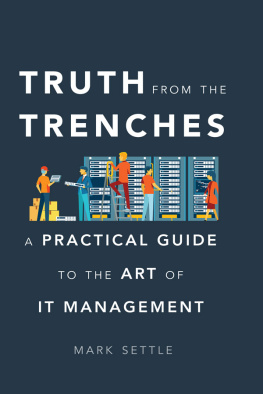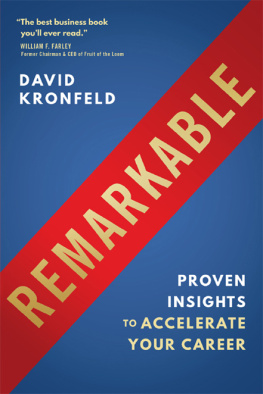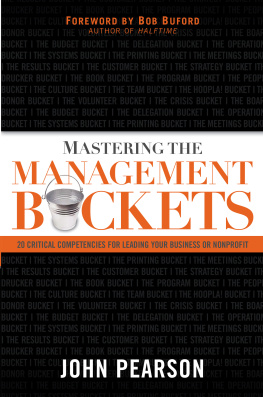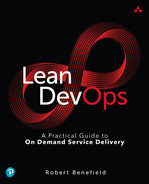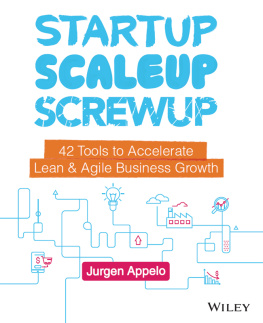First published by Bibliomotion, Inc.
711 Third Avenue, New York, NY 10017, USA
2 Park Square, Milton Park, Abingdon, Oxon OX14 4RN, UK
All rights reserved. No part of this publication may be reproduced in any manner whatsoever without written permission from the publisher, except in the case of brief quotations embodied in critical articles or reviews.
CIP data has been applied for.
This book is a collection of observations, insights, and recommendations about how to lead and manage an IT organization. It is not intended to be a handbook or users manual prescribing the processes required to run an IT shop. Nor is it intended to be an academic discussion of the strategic challenges confronting todays IT leaders. It is an unapologetieally subjective view of the common pitfalls and opportunities faced by all IT leaders.
IT management is part science and part art form. A common framework of operational practices exists in all IT organizations. All IT shops need to respond to technical problems, update existing systems, obtain business approval for new investments, safeguard company information, and so on. Although this common framework exists, there is wide latitude in the form, substance, and prioritization of the specific work practices employed within different organizations.
Variations in work practices can be attributed to many factors, including the size of the organization, the business processes it supports, its technical sophistication, its company culture, and the prior experience of the organizations leaders. Work practices in a Fortune 500 insurance company running largely on homegrown systems will inevitably be quite different from those in a SaaS start-up company with fewer than a thousand employees.
The geographic dispersion of IT staff members can also have a big impact on internal work practices. The practices established within a highly centralized IT team based in North America tend to break down when they are extended to manage operations in different countries, time zones, and cultural settings. As businesses become more global in nature, many IT organizations learn that the processes theyve developed in North America are either being openly ignored or discreetly subverted in their overseas offices.
Consequently, there is no one right way to manage an IT organization. But there are many chronic pitfalls. One of the primary purposes of this book is to identify the pitfalls that can so easily undermine the success of aspiring IT leaders.
IT management is more of a craft that needs to be honed through on-the-job experience than a profession that can be learned in a classroom. Many professions such as law and accounting have rigorous certification processes to ensure the consistency and integrity of the work practices employed by their practitioners. There is no comparable certification process for IT management. Even widely accepted management frameworks for software development (e.g., the Carnegie Mellon Capability Maturity Model) or IT operations (e.g., the Information Technology Infrastructure Library [ITIL]) are nothing more than a collection of guidelines. They are not codified bodies of knowledge that must be followed in detail to obtain external certification. ITIL consultants will frequently tell you that the ITIL framework is not a prescriptive cookbook of best practices. Rather it should be treated as a book about cooking. Each IT shop needs to develop its own unique set of operational practices.
From my admittedly biased perspective, I believe that managing IT is more complex than managing many of the other corporate functions in a global enterprise. Finance teams follow a work schedule that is largely prescribed by the monthly accounting close, the quarterly close, the quarterly earnings call with investment analysts, board meetings, and external presentations at investor conferences. They are required to adhere to a variety of fiduciary standards and regulatory requirements. The integrity of their internal processes is reviewed continuously by internal and external auditors and reported to the Audit Committee at every Board of Directors meeting. Similarly Human Resources (HR) administers a prescribed set of programs, including employee performance reviews, merit and bonus awards, benefits enrollment, succession planning, applicant tracking, etc. Although HR work processes are not audited explicitly, HR also operates within a stringent regulatory environment and needs to avoid creating liabilities for the company by failing to comply with such regulations.
Success in functions such as Finance and HR can be measured in terms of completing prescribed activities on schedule and in strict compliance with all relevant external standards and regulatory rules. IT success is more difficult to measure because there are far fewer prescribed activities, and success is largely based on the perceptions of business colleagues who consume IT services. For example, the finance team can produce a flawless 10-Q report on a companys quarterly performance that is judged to be successful by the SEC, the board, and the companys auditors. In contrast, IT can expand network capacity or upgrade the CRM system, but the success of such initiatives will ultimately be judged by business colleagues who employ these capabilities to perform their jobs.
I believe this contrast exists with other functional groups as well. Manufacturing and supply chain operations have well-established metrics regarding throughput, unit costs, and inventory velocity that must be met to achieve predetermined returns on investment or working capital. Sales and marketing teams also have objective performance metrics regarding lead generation, quota coverage, deal closure rates, and subscription renewal rates. If properly managed, none of these functions relies on internal perceptions to judge its success. All have established success metrics that are accepted and respected by other functional groups. In contrast, IT typically establishes a set of technical metrics to manage internal operations, but these metrics are unknown or poorly understood by business leaders. There are many, many cases where IT credibility is low even while the technical metrics being used to track internal operations are at or above targeted levels.
Experiential learning becomes the primary educational mechanism in a profession that lacks formal certifications and relies on its customers to define success. Although I hesitate to claim that effective IT management practices can only be developed through trial and error, I am convinced that they cannot be taught in the classroom. Much like medieval artisans, accomplished IT leaders have typically passed through apprentice and journeyman stages in their careers before achieving the skills and status of master craftsmen.
They Dont Teach Real-World IT in School
If you believe that colleges prepare students for careers in the IT industry, you should spend a day manning a recruiting booth at a campus job fair for summer interns. College students generally understand the processes involved in developing applications or building websites. They can readily relate to roles they might play in coding and testing application software. However, when you start to describe other projects they might encounter during a summer internship experience, their eyes glaze over and they rapidly lose interest because they have no earthly idea what you are talking about. Typical work assignments for summer students might include resolving CMDB discrepancies created by different infrastructure discovery tools; optimizing extract/transform/load procedures for nightly updates to the data warehouse; documenting user requirements and building scripts to test such requirements; tuning intrusion detection tools to reduce the occurrence of false positive events; testing upgrades to hardware or software systems before they are put in production; and evaluating competitive product offerings from two or more vendors. These are basic bread-and-butter activities within any IT shop, but they are totally beyond the comprehension of undergrads at most, if not all, major universities.

